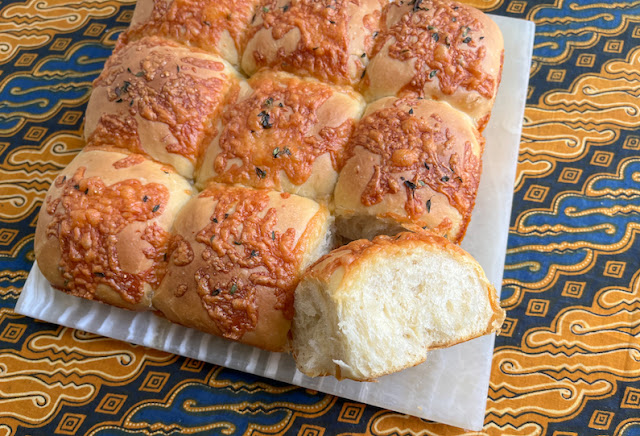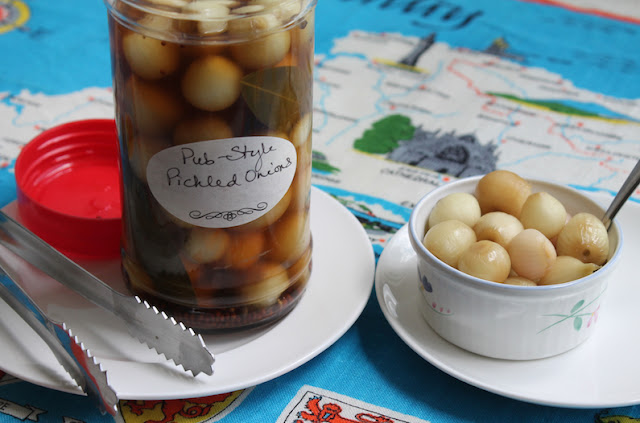These French onion soup rolls have all the flavor of French onion soup in bread form! They are a great snack or accompaniment to any soup or stew. Or split them like a bun to use them for special sandwiches. The cheesy onion "jam" inside is fabulous.
Who doesn’t love a hot bowl of French onion soup, topped with crusty bread and melted cheese? I know it’s one of our favorites to eat at home and certainly to order in any French bistro.
When this month’s Bread Baker’s host decided on the allium family as our theme for today’s event, I had what I thought was the brilliant and unusual idea of turning the flavors of French onion soup into a yeasty bread. Initially I was going to make a rolled loaf filled with cheese and caramelized onions but, as it turns out, my idea wasn’t so unusual.
There are lots of recipes for French onion soup flavored bread! Who knew? The one I ended up adapting was for stuffed rolls and I must say, they are delicious! We ate them plain, with sliced corned beef roast and, one morning, I even made a fried egg sandwich with one. So good!
French Onion Soup Rolls
This recipe is adapted by one from A Cozy Kitchen. The original makes a 9x13 pan full so I halved the recipe and also changed up the method. The rolls bake up fluffy and soft!
Ingredients
For the dough:
2/3 cup or 157ml milk, lukewarm
2 teaspoons sugar
2 1/4 teaspoons or 7 grams active dry yeast
2 1/4 cups or 281g all-purpose flour
1/2 teaspoon fine sea salt
2 tablespoons unsalted butter (melted and cooled), plus extra for the baking pan
1 large egg
1 teaspoon olive oil for the dough bowl
For the caramelized onions:
1 tablespoon unsalted butter
2 large sweet onions, peeled and thinly sliced (I used a mandoline!)
Leaves from 2-3 sprigs fresh thyme
Fine sea salt
For the rolls:
3 oz or 85g gruyere or cheddar cheese, grated
Fresh thyme leaves for garnish
Method
Butter a 9x9 in or 23x23cm baking pan. Add the yeast and sugar to the warm milk and set aside to proof for about five minutes. The yeast should get bubbly. If it does not, you need to buy new yeast and start over.
Mix together the flour, milk/yeast mixture, melted butter and salt in the bowl of your stand-up mixer (with the hook attachment.)
Add the egg to the flour mixture and knead with the mixer on medium speed for about 5 to 7 minutes, until smooth and elastic.
Cover it with cling film and leave to rise for 30-40 minutes. (If your kitchen is cold, as mine is right now, you can put the dough bowl in another bowl or your sink filled with warm water.)
While the dough is rising, we’ll caramelize the onions. Add the butter to a wide-rimmed pan set over medium heat and add the sliced onions, thyme, and season lightly with salt.
Reduce the heat to medium-low, add a tablespoon or two of water and cover the pan for 15 minutes to soften the onions.
Remove the lid and stir every few minutes, until the onions are caramelized. I kept the fire pretty low so mine took quite a while.
A higher flame will caramelize the onions faster but you really have to be stirring a lot to make sure they don't scorch. Remove the onions from the heat and transfer them to a plate, spread out to cool.
Punch down the dough.
Divide it into 9 equal pieces and roll them into balls. If you want them to be the same exact size, you can weigh them out. Each piece of dough should weigh around 58 grams.
On your plate, divide the caramelized onions into 9 equal portions. Using HALF of the grated cheese, top each portion of caramelized onions with about 1/9 of the cheese.
Use your hands to press each dough ball into a circle and put the onion/cheese mixture in the middle.
Cover the baking pan with a cling film and let the rolls proof for about 1 to 1 1/2 hours. The rolls should at least double in size.
When your rolls are almost finished the second rise, preheat your oven to 350°F or 180°C. Sprinkle on the remaining grated cheese and fresh thyme leaves.
As I mentioned above, it’s Bread Baker day and our theme is the allium family with includes onions, garlic, leeks and, believe it or not, about 920 species in all! Many thanks to our host, Karen of Karen’s Kitchen Stories! Check out the list of lovely breads below:
- French Onion Soup Rolls from Food Lust People Love
- Garlic Cloverleaf Rolls from Passion Kneaded
- Garlic Confit Focaccia from What Smells So Good?
- Gluten-Free Millet Chives Flatbread (Bajra chives Paratha) from Cook with Renu
- Moroccan Rghaif from Sneha’s Recipe
- Onion and Bay Loaf from A Messy Kitchen
- Onion Garlic Loaf from Ambrosia
- Onion Lover Rolls from A Day in the Life on the Farm
- Scallion and Sesame Rolls from Karen’s Kitchen Stories
- Whole Wheat Onion Kulcha from Magical Ingredients

















.png)









.png)




























